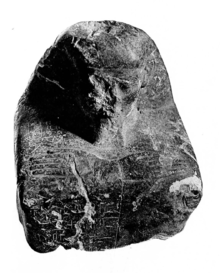Djehutyemhat
Djehutyemhat,[2] or Thotemhat,[3] was an ancient Egyptian ruler ("king") of Hermopolis during the 25th Dynasty.
| Djehutyemhat | |||||||||||||||||||||||||||||||||||||||||||||||||||||||||||||||
|---|---|---|---|---|---|---|---|---|---|---|---|---|---|---|---|---|---|---|---|---|---|---|---|---|---|---|---|---|---|---|---|---|---|---|---|---|---|---|---|---|---|---|---|---|---|---|---|---|---|---|---|---|---|---|---|---|---|---|---|---|---|---|---|
| Thotemhat | |||||||||||||||||||||||||||||||||||||||||||||||||||||||||||||||
 Statue of the priest Tjanhesret, bearing the cartouches of Djehutyemhat. Cairo Museum, CG 42212. | |||||||||||||||||||||||||||||||||||||||||||||||||||||||||||||||
| King of Hermopolis | |||||||||||||||||||||||||||||||||||||||||||||||||||||||||||||||
| Reign | c. 725 - 710 BCE[1] | ||||||||||||||||||||||||||||||||||||||||||||||||||||||||||||||
| Predecessor | Nimlot[1] | ||||||||||||||||||||||||||||||||||||||||||||||||||||||||||||||
| Successor | Pedinemty? | ||||||||||||||||||||||||||||||||||||||||||||||||||||||||||||||
| |||||||||||||||||||||||||||||||||||||||||||||||||||||||||||||||
Biography
Like his probable predecessor Nimlot, he proclaimed himself king, adopting the full royal titulary although he was no more than a governor of Hermopolis and a vassal of the Kushite 25th Dynasty. His cartouches appear carved on the shoulders of a damaged block statue depicting the priest Tjanhesret, found in Luxor in 1909 and now in the Cairo Museum (CG 42212), and on a bronze naos-shaped amulet of Amun-Ra of unknown provenance – possibly from Thebes – and now in the British Museum (EA11015).[3][4][5] The only known depiction of the king is found on a votive scribal pallet now in the collection of the Egypt Centre of Swansea University.[2]
British Egyptologist Kenneth Kitchen has suggested that the successor of Djehutyemhat could have been the poorly known "king" Pedinemty.[6]
Notes
- Wenet was the 15th district of Upper Egypt, with Hermopolis as capital.
References
- Kenneth Kitchen, The Third Intermediate Period in Egypt (1100–650 BC), 1996, Aris & Phillips Limited, Warminster, ISBN 0-85668-298-5, table 16B
- Troy Leiland Sagrillo. 2017. “King Djeḥuty-em-ḥat in Swansea: Three model scribal palettes in the collection of the Egypt Centre of Swansea University.” In A true scribe of Abydos: Essays on first millennium Egypt in honour of Anthony Leahy, edited by Claus Jurman, B. Bader, and David A. Aston. Orientalia Lovaniensia Analecta 265. Leuven: Uitgeverij Peeters. 385-414.
- Spencer, P.A. & Spencer, A.J. (1986), "Notes on Late Libyan Period", JEA 72, pp. 198–201
- Kitchen, op. cit., § 109; 331
- The bronze naos-shaped amulet EA11015 at the British Museum.
- Kitchen, op. cit., § 525
